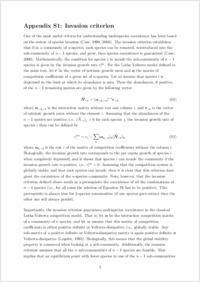A structural approach for understanding multispecies coexistence
- Saavedra, Serguei Department of Civil and Environmental Engineering, MIT, Cambridge, MA, USA
- Rohr, Rudolf P. Department of Biology - Ecology and Evolution, University of Fribourg, Fribourg, Switzerland
- Bascompte, Jordi Department of Evolutionary Biology and Environmental Studies, University of Zurich, Zurich, Switzerland
- Godoy, Oscar Instituto de Recursos Naturales y Agrobiología de Sevilla (IRNAS-CSIC), Sevilla, Spain
- Kraft, Nathan J. B. Department of Ecology and Evolutionary Biology, UCLA, Los Angeles, USA
- Levine, Jonathan M. Institute of Integrative Biology, ETH Zurich, Zurich, Switzerland
-
2017
Published in:
- Ecological Monographs. - 2017, vol. 87, no. 3, p. 470-486
community dynamics
feasibility
invasion criterion
multiple competitors
niche and fitness differences
pairwise effects
structural stability
English
Although observations of species-rich communities have long served as a primary motivation for research on the coexistence of competitors, the majority of our empirical and theoretical understanding comes from two-species systems. How much of the coexistence observed in species rich communities results from indirect effects among competitors that only emerge in diverse systems remains poorly understood. Resolving this issue requires simple, scalable, and intuitive metrics for quantifying the conditions for coexistence in multispecies systems, and how these conditions differ from those expected based solely on pairwise interactions. To achieve these aims, we develop a structural approach for studying the set of parameter values compatible with n-species coexistence given the geometric constraints imposed by the the matrix of competition coefficients. We derive novel mathematical metrics analogous to stabilizing niche differences and fitness differences that measure the range of conditions compatible with multispecies coexistence, incorporating the effects of indirect interactions emerging in diverse systems. We show how our measures can be used to quantify the extent to which the conditions for coexistence in multispecies systems differ from those that allow pairwise coexistence, and apply the method to a field system of annual plants. We conclude by presenting new challenges and empirical opportunities emerging from our structural metrics of multispecies coexistence.
- Faculty
- Faculté des sciences et de médecine
- Department
- Département de Biologie
- Language
-
- English
- Classification
- Biological sciences
- License
-
License undefined
- Identifiers
-
- RERO DOC 288903
- DOI 10.1002/ecm.1263
- Persistent URL
- https://folia.unifr.ch/unifr/documents/305381
Other files
Statistics
Document views: 175
File downloads:
- pdf: 320
- Supplementary material: 185

